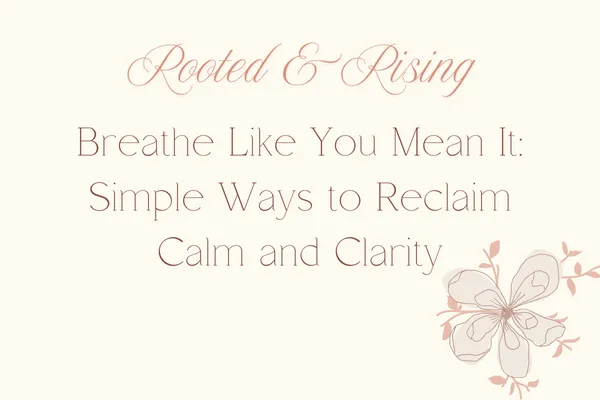
Breathe Like You Mean It: Simple Ways to Reclaim Calm and Clarity
“Your breath is your anchor—always available, always steady, no matter the storm.” - Unknown
Throughout each season of my life, my passions have evolved.
At one time, it was all about friendships and fun. Then came the search for a soul mate. For many years, my focus was completely on raising my kids—they were (and still are) one of my greatest joys. But as they grew up and started needing me less (at least outwardly), I realized that if I didn’t find something else to focus on, I’d end up smothering them with my very well-intentioned ‘helpful advice’—and let’s be honest, that’s a fast track to being muted in the family group chat. So I went back to school, diving into natural health, which led me to meditation… and eventually to breathwork. That’s where I landed almost two years ago, and I haven’t looked back. I study it, practice it, and share it as often as I can. And I’m thrilled to see breathwork finally getting the attention it deserves.
What yogis have practiced for thousands of years is now being supported by science: how you breathe truly shapes how you feel.
From your sleep and energy to your mood, digestion, and even brain function, your breath is quietly running the show. The best part? Unlike your heartbeat or hormones, your breath is one function you can actually guide on purpose.
I want to share with you how—and why—breathing better could be the reset your body and mind have been waiting for.
Why Breathing Matters More Than You Think
Breathing is one of the only automatic functions in your body that you can also control. That’s not a coincidence—it’s a built-in tool to help you shift gears.
When you guide your breath with intention, you can calm your nervous system, restore focus, and bring your body into balance.
But here’s the catch: many of us are breathing in ways that work against our health, without even realizing it.
Signs Your Breathing Might Need a Reset
If you’ve noticed any of these signs, your breath might need some attention:
You sigh, yawn, or feel short of breath often
You catch yourself breathing through your mouth (day or night)
You wake up tired even after sleeping all night
You feel wired, anxious, or overwhelmed for no clear reason
You experience brain fog, fatigue, or body tension
These are all signals that your breathing pattern might be sending your body into “stress mode”—even when you’re just sitting at your desk.
How Dysfunctional Breathing Affects You
Breathing too fast, too shallowly, or through your mouth can trigger a stress response. It lowers carbon dioxide (CO₂) in your blood—which your body needs in healthy amounts to absorb and deliver oxygen efficiently. Without enough CO₂, your cells don’t get the oxygen they need, and your body stays in a state of low-level alertness or even panic.
Over time, this can leave you feeling tired, tense, or foggy, even when everything else seems “fine.”
What Healthy Breathing Looks Like
Let’s keep it simple. Good breathing:
Flows through the nose, not the mouth
Is slow and gentle, especially at rest
Starts low in the direction of the belly, then moves up to the ribs and chest
Includes soft, relaxed exhales
Even if you’re not ready for a full breathwork routine, just becoming aware of these basics can shift how you feel in a powerful way.
Try This: 3-Part Breath Practice (5 Minutes a Day)
This gentle exercise helps you practice healthier breathing mechanics while reconnecting with your body.
Here’s how:
Sit or lie comfortably. Place one hand on your belly and one on your chest.
Inhale through your nose slowly—breathe into your belly first, then expand your ribs, then lift your chest slightly.
Exhale gently through your nose, allowing your body to soften.
Repeat for 5–10 minutes. Try to make each breath silent and smooth, like a quiet ocean wave.
Tip: Count your breaths for one minute. Aim for 6–10 breaths per minute. Slower isn’t always better, but over time, training yourself to breathe within this range can bring a sense of calm and clarity.
Small Habits, Big Shifts
You don’t have to master anything overnight. Breathing well is a practice, just like learning to eat differently or move your body in new ways.
The beauty is that you already have everything you need—your breath is always with you.
Start today with one simple step:
Close your mouth and breathe through your nose while reading, working, or walking.
The more you practice, the more natural it becomes. And when your breath is working with your body, not against it, you’ll start to feel the difference—in your energy, focus, sleep, and mood.
